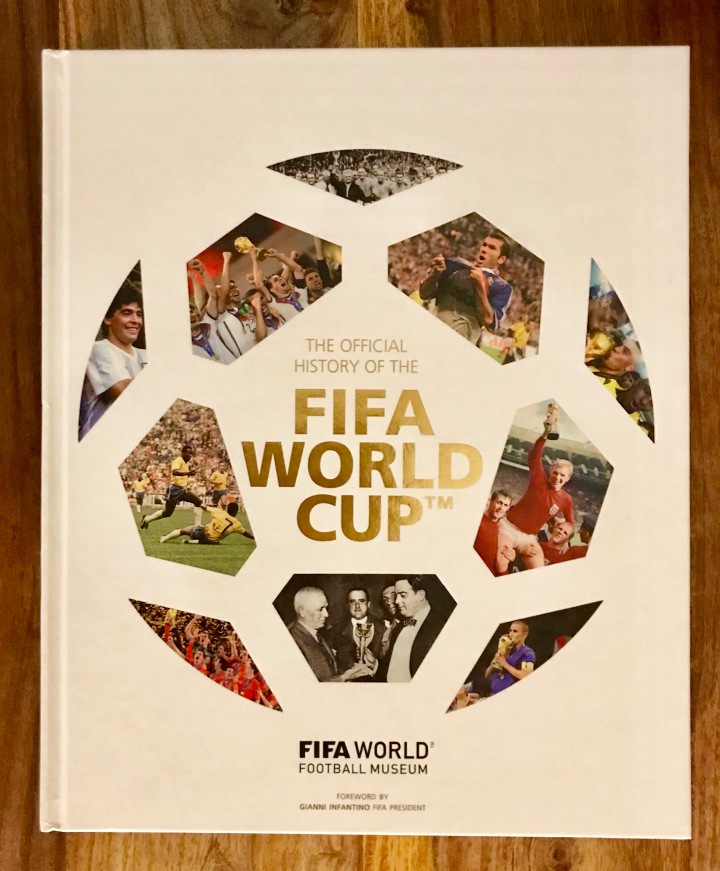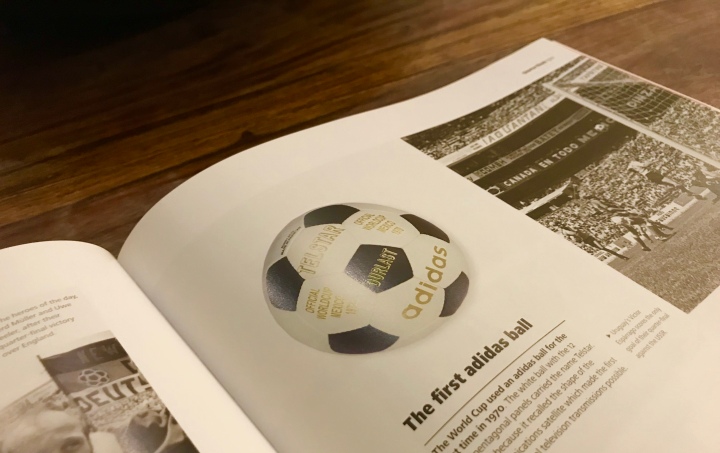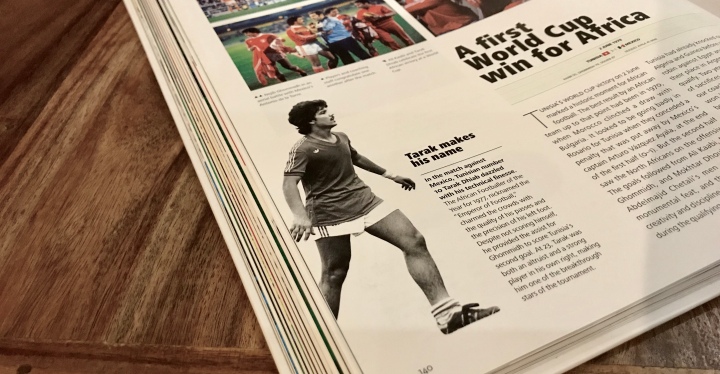
The Official History of the FIFA World Cup
First Published 2017
304 pp, Carlton Books
This is the first book published by the FIFA World Football Museum. It is an ideal gift for any World Cup enthusiast and covers all the World Cup tournaments from their beginnings in Uruguay until the 2014 championship, where Germany lifted the cup in Brazil. It is packed with interesting information, first hand experiences and memories as related by the key players themselves, and images, illustrations and iconic photos. Beyond the gold-fly sheet there is truly a treasure to discover.
An ideal accessory on the living room table during the World Cup season. An item to flick through and a conversation starter whilst watching a game where the goals simply do not happen or kick in a little late in the game. And I assure you that everytime you will flick through, you will certainly learn something new.
Besides, it is amazing how much politics was and still is an integral part in the evolution of the World Cup. So, really this book is an interesting read for the history lover as well.
Conveniently published a year before the competition kicked off (I got my hands on it a couple of weeks ago), the reader had ample time to study all the interesting information and profess him or herself as a football expert and bestow lovely snippets of trivia during any game.
Here are some facts that caught my family’s fancy:
- Although the 1930 marks the birth of the World Cup, FIFA was created in 1904 and the first world championship (not exactly the World Cup) took place in 1908… but it was different from what it is today! Just imagine, in 1930 (the first official World Cup) Bolivia’s coach also acted as a referee and a linesman (when his boys were not playing)… and his assistant referee was the Romanian coach…🤨
- Although the Dutch have never won the tournament, they can claim that one of their own is the ‘father’ of the World Cup. Cornelius Wilhelm Hirschman came up with the idea of an international championship in 1902! He was a key figure in the creation of the World Cup (FWC) 28 years later. 👏
- Brazil once wore a white t-shirt, but after the 1950 World Cup “final” match when Brazil lost 2-1 to Uruguay, it was considered cursed, and the now-emblematic yellow and green shirt, blue shorts and white socks would be worn for the first time against Chile in 1954. Also following that loss, Brazil stopped playing international football for 2 YEARS!!!!

My son drawing the ‘cursed’ white t-shirt of Brazil. - In 1954 West Germany won the FWC title (no news). What if the boots were the winning ingredient? That year the Germans’ boots were revolutionary, first because of the newly designed studs by Adidas which helped the Germans adapt to all sorts of pitch conditions, and secondly because these new boots weighed 700g as compared with 1.5 kgs for the conventional boots worn by the Hungarians.
- 1958, and Pelé became the youngest player to take part in the World Cup, the youngest player to score in a FWC and the youngest player to score a hat-trick! After the final match against Sweden, Sigge Parling, the Swedish centre-half, said “after the fifth goal, I no longer wanted to defend against Pelé I just wanted to applaud.” I LOVE FOOTBALL!
- In 1962, Pelé, then 21, pulled a muscle in his groin (ouch) during a game against Czechoslovakia; he continued the match, and when the ball came his way the Czech defenders refrained from tackling him so as not to aggravate his injury …. that’s what I consider being a role model, that’s some perspective and love, and Pelé himself was deeply touched.
- 🏴1966, and football comes home, England wins the Cup. The national joy and satisfaction are probably only second to the personal vindication of Ramsey, the manager of the team. He was subject to fierce criticism from the moment he took up this post in 1963, and many ridiculed him when he stated that he was going to win the World Cup. Talk of determination and resolve! (Did Southgate predict a second win?)
- Mexico 1970 – regarded by many as one of the very best World Cups; epic matches, first broadcast in colour and the introduction of the red and yellow cards (in previous World Cup editions the referee would caution players or tell them to leave the pitch, but the use of cards and the drama that surrounds them was still a novelty in 1970).
- Also in 1970 we find the introduction of the white ball with the 12 black pentagonal panels – the Telstar Durlast. The pentagonal panels were inserted to recall the telecommunication satellite which made the transcontinental transmissions possible.⚽️

The Telstar Durlast - Another novelty for the Mexico 1970: the Panini stickers!!!!
- Africa’s first world cup win took place in 1978, when Tunisia won against Mexico 3-1. The star of the match was Tarak Dhiab, who enthralled the viewers with his technical mastery.

Tarak Dhiab, “Emperor of Football” - The Argentine star of 1978 was Kempes. Interestingly enough he started scoring only after shaving his beard and moustache. Maybe Messi needed to shave his too during this World Cup! Just saying!
- 11th July 1982, World Cup final between Italy and West Germany (which Italy won) and Madrid heard a roar, it was Marco Tardelli’s roar. About the roar Tardelli had the following words to say “I was born with the roar, it didn’t just emerge at that moment. You live your life and have some good experiences and some bad ones. Then it all comes out at that moment”. Next time I feel like roaring I have an explanation handy 😉.
- Most people with a little interest in World Cup history will know what the hand of God refers to… Maradona and the quarter-final against England in 1986. What most do not know is his brass-faced response to questions following the match: “I don’t regret and will never regret the goal I scored with my hand against the English.” AMAZING!!!!!
- Argentina was feeling the pressure in Russia 2018… a lot of pressure. But really Argentina is known to feel the pressure. In the 1990 group stage Carlos Bilardo (the manager) had stated “If we’re going to be knocked out like that, I hope our plane home crashes”. If on that plane there was only him, maybe, but to drag the whole team with him…. really?🤨
- So, I would rather remember Italia ‘90 like this: Toto Schillaci being awarded the Golden Ball for best player and the Golden Boot for top scorer and Walter Zenga’s record of 517 minutes without conceding a goal😉.
- 🇭🇷1998 was Croatia’s debut year, and they took third place. Twenty years on and they have a chance of getting through to the final. Good luck boys😊.🇭🇷
- 2006 is so far the FWC in which the most yellow cards were given, 345 to be precise. Russia 2018 stands at 210 (my son helped me to count them, one match after another) and with only 3 games left to play it is highly unlikely that this record will be broken. Is it possible that the yellow card rule is leaving its mark?
- Germany – England (27th June 2010) was a match that called for Goal Line technology. For England the ball was in, for the Germans and the referee it was not. Yet it was clearly in. Goal Line technology would then be introduced in the 2014 FWC.
This book is truly a treasure cove of information and images. 304 pages brimming with well presented and documented lore, to be cherished and passed on to future generations 😊.

